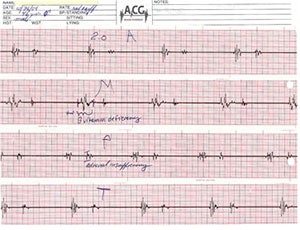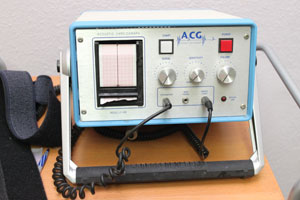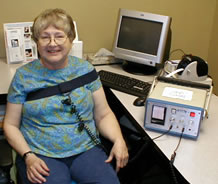Acoustic Cardiograph

The Endocardiograph was developed in 1937 by Dr. Royal Lee. It was modernized with transistors to become the ACG. One of the most powerful tools used in integrative and nutritional therapy is the ACG recording along with other lab tests..
The ACG records the vibrations of the heart as the blood moves through the various chambers, valves, and large vessels, hence the name Acoustic CardioGraph. The ACG records these vibrations at four locations of the heart and provides a "graph signature." While the opening and closing of the heart valves contributes to the graph, so does the contraction and strength of the heart muscle. As a result a dynamic picture is presented of the heart in motion. If the heart is efficient and without stress, the graph is smooth and clear. If the heart is inefficient, there are definite patterns associated each type of contributing dysfunction.

The ACG is not the same as an electrocardiograph (EKG), which is a common diagnostic test. The EKG records only electrical impulses as they move through the nerves of the heart tissue. The EKG primarily indicates if the nervous tissue network of the heart is affected by any trauma, damage (for example from a prior heart attack or infection), severe nutritional imbalances, stress from excessive pressure. Only the effect on the nervous system is detected.
The ACG not only looks at electrical function but also looks at heart muscle function, which serves as a window of the metabolism of the entire nervous system and the muscles. Using the heart allows a "real-time" look at the nerves and muscles working together. As a result of this interface, unique and objective insights into health of the heart and the entire person can better be seen.

Royal Lee was well aware of the value of the ACG since he proclaimed, "The heart is the most reflective muscle of balanced nutrition or malnutrition…" In other words, the ACG report enables the doctor to "hear" by "seeing" heart function on the graph. In this way the heart sounds (technically the vibrations) serve as a reflection of the balanced body chemistry, nutrition, and overall function of your body's systems. The ACG thus changes the focus from detecting disease to prevention and nutritional support not just of the heart but of the heart and the patient.
While we are careful not to discuss using the ACG to make a "diagnosis", the ACG "signature graphs" can suggest:
- Whether your muscle function is optimal.
- If your body's chemistry is balanced.
- Are there nutritional imbalances or deficiencies.
- Vitamin B need
- Vitamin E need
- Tendency toward poor oxygenation
- Electrolyte deficiency
- Need for fatty acids
- Calcium utilization
- Adrenal function
- Pulmonary pressure
- Is your blood pressure (even if "normal") straining your heart?
- Liver and gallbladder Stress
By monitoring the ACG over time, the effectiveness of your nutritional and lifestyle program can be assessed.
Each type of imbalance, deficiency or dysfunction has a characteristic "graph signature". The ACG helps detect such dysfunctions and deficiencies, and the supportive treatment takes these observations into account.


